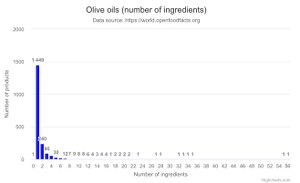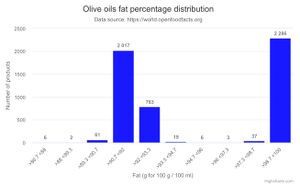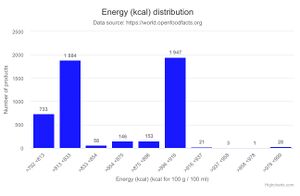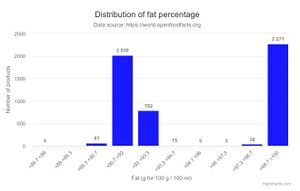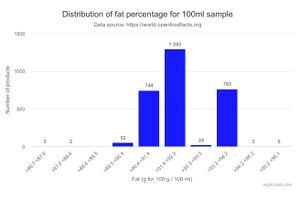Olive oil - en
Introduction
In november 2020 @stephane asked to have a look at the products in the olive oil category. The category was in need of cleaning up. An olive oil should have a Nutriscore D or C, but other values were seen. So I had a look at the products and cleaned a bit. This post is a log of my observations.
Background
Olive oils are a special category for Nutriscore, as they are a special case for the score calculation. Olive oil is seen as one of the better oils, and thus may get a better score. This exception was recently introduced (a refrence here?).
However all oils are bad, so olive oil will never get a better score than C. This has provoked a lot of resistance in Italy and Spain, as olive oil is seen as a major export product. Those countries might leave out olive oil from the Nutriscore obligation.
Definition
https://en.wikipedia.org/wiki/Olive_oil is a simple product: it has only one ingredient: olives. The extraction process and origin might influence the actual composition of oils. This might be visible in the nutritional values and labelling on a product.
Completeness
On 13 dec 2020 the https://world.openfoodfacts.org/category/olive-oils is comprised of 6118 products. There might be olive oil products, which are not labelled as such.
Robotoff comes here to the rescue, as it might have found some eligible products. On 13 dec 2020 there were no remaining questions on Robotoff.
Missing data
There are many products for which we have no nutritional data. Clearly there is a role for Robotoff to play here. It is impossible to do it by hand.
Interlopers
Are all the products in the Olive oils category indeed olive oils. We need to find the products that are not olive oils (the interlopers).
Number of ingredients
A first check is to look at the number of ingredients. And it turns out that are some products that seem wrongly classified.
Note that of the 6118 products only 1967 seem to have ingredients defined.
Not sure how I can list the products with more than 1 ingredient.
Another way to fin interlopers is by looking for strange nutritional values, but that can also be due to wrongly entered data.
Data quality
Nutritional values check
A next step to correct wrong nutritional data, I started by looking at the fat percentage. There are 6 products with more than 100% fat, so lets correct those first. It easier to list those with a query and correct them. For these products the wrong data has been added. One product had a fat content of 101g though.
The next edit round looks at fat percentages lower than 88%.
The final result of the fat percentage distribution. Note that the distribution has two peaks, one around 100% and one around 90%. It seems that some producers assume that their olive oils consist of 100% fat and others really have it measured.
Now that I did the fat percentage, I realised that I have to go through all nutritional values and look at values that are out if the ordinary.
Other checks
The nutritional values check also allowed to remove wrongly assigned products (very few).
I also added ingredients images, did the recognition and added subcategories.
Typical errors
I repaired the following errors:
- wrong classifications
- mixup between per serving and per 100g data
- all nutritional values set to 0
- forgotten to check per serving
- no total fat percentage on label
- some yuka users converted the per serving to per 100g values
Olive oil conclusions and thoughts
States overview
After having repaired most of the olive oil products, we can make an overview of the states.
Some highlights (status on 16 dec 2020):
- Total in category: 6043
- Has nutritional values: 5380 (89%)
- Has ingredients: 1971 (33%)
Ingredients
What are the ingredients. Now we see mostly written olive oil, or something like that. But does that convey anything? Preferably we would like to know the olive variety (or varieties). The origin of the olives and the processes applied to extract the oil. Words like virgin, extra virgin, cold-pressed, AOP, the origin of the olives, etc provides more information and is good information.
Serving size
The products sold in the note a serving size on 15 ml on their packaging, which is equivalent to 1 tablespoon. Instead of the 15 ml, a weight of 14 g can be given. This weight corresponds to the specific gravity of 0.911 of olive oils (wikipedia). On products sold in Europe a serving size of 10 ml can sometimes be found. The usefulness of having a serving size for a cooking aid can be debated. In fact 15 ml seems a lot.
Canonical nutritional values
Many products use, what seems as, standard canonical values for nutritional values. The canonical values for energy (wikipedia) are 3700 kJ or 880 kcal. The products use 900 kcal instead. In total there are 1957 products with this value.
The distribution shows this effect even more clearly:
As expected the same double peak is also seen in distribution of Energy in kJoule.
The distribution of the fat percentage also shows a double peak:
This seems more strange. You would expect that an oil consists of 100% fat, or maybe a bit less if there are impurities. The other peak lies around the 91%, very much like the specific gravity of 0.991.
Conclusion is that some producers report their nutritional values per 100g, some per 100ml and some use the canonical value of 100% (2193). A few product have values close to 100%, which seems most honest.
If we have a look at the 100ml sample:
Interestingly we have another distribution with two peaks. So where does the upper peak come from. Looking at the origin of the data, it looks like these products have nutritional values listed per serving. The canonical US value is 120 Cal.
Subcategories
OFF has defined multiple subcatgories based on origin (country) or listed quality (virgin, extra virgin).
The virgin olive oils use a first pressing of olives. The second extraction is based on what is left over and are called pomace olive oil (wikipedia). OFF seems to have used refined olive oils as a label for this category. We should change this to correspond better to wikipedia.
Possible origins are now France, Greece and Italy. We should add Tunisia, Spain.
New categories
By looking more closely at all the products we can identify other categories. Only if there are a lot of products in each category or if the nutritional values deviate to much, it is worthwhile to create these new products
- pure olive oils: the current olive oils category should be renamed to pure olive oils to indicate that these products contain only one ingredient. This helps also to distinguish from the other olive oils.
- olive oil sprays for olive oil contain other ingredients to make it sprayable. As the serving is only 0.25g, the nutritional values per serving are all zero (thanks to rounding).
- enhanced olive oils: these olive oils have added vitamins for children(?)
- flavoured olive oils: these olive oils have added flavours (garlic, etc.)
- Blend of olive oils: some oils are a blend of refined and virgin olive oils.
- Blend of virgin olive oils: some olive oils name multiple countries as origin of their oils. These can be assigned to a new category, which says it is a mix of oils.
What nutritional element is missing?
If the total fat content of olive oils is around de 92%. What is the remaining fraction of 8%. It is not indicated as nutritional value. Can it be water?
Vitamins
Quiten often the Vitamin E and Vitamin A are indicated. Quite strange. As if you are going to take olive oil for your vitamins. I guess the producers want to improve the health standing of their products.
Fat details
NOVA
What should be the value of the NOVA-score for olive oils? It seems to be now mainly NOVA 2. But shouldn't it be NOVA 3 for non-virgin olive oils. The pomace oils are created through chemical processes. A NOVA downgrade seems appropriate. This would also mean that the standard value for the category Olive oils would be NOVA 2, only if the product would be assigned to Virgin olive oils, it would turn NOVA 2.
Nutriscore
Eco-score
OFF Conclusions and thoughts
- OFF quality
During the cleanup I edited a lot of products. This gives an indication of the quality of the OFF data. The counter stands at 318 products if the 6115, i.e. 7%. This is not yet the final figure.
- Quality indicators
Many olive oils sold in the USA show extra quality indicators (eg this one). We could add these parameters to the nutritional values. These are mainly expressed as limits (less than or more than).
- US import issues?
Many US product are not indicated by serving. In the total fat field, the monounsaturated fats are shown. Did we have an import issue?
- Quality check
Can the verified average values be used as a quality check on new products? A flag could be raised if one of the nutritional values is outside the allowed range.
- Missing Ingredients
Many products have no Nova calculated as their ingredient list is empty. Could we default to olive oil as ingredient? We could define this category as a base food with a single ingredient. This in turn could be used as quality check.
- Wrong nutritional values
Several products present nutritional values that is clearly wrong. Now I edited these out. I rather leave them and raise a flag, so that they are not used in the calculations.
